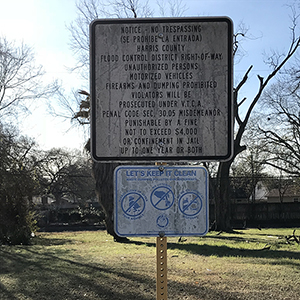 Home buyout programs intend to help those whose homes are repeatedly damaged by floods and other disasters, but their usefulness as mitigation and recovery tools are still being examined. ©Sherri Brokopp Binder, 2018.
Home buyout programs intend to help those whose homes are repeatedly damaged by floods and other disasters, but their usefulness as mitigation and recovery tools are still being examined. ©Sherri Brokopp Binder, 2018.
By Sherri Brokopp Binder and Alex Greer
Given recent hurricane and flooding impacts, the risks and realities of climate change, and the unsustainability of the National Flood Insurance Program, public officials are looking to home buyouts to reduce disaster losses.
Home buyout programs facilitate the large-scale relocation of residents out of risky areas. We have been researching these programs for several years, yet we routinely find ourselves asking a seemingly elementary question: should home buyouts be considered mitigation programs or recovery programs?
This question raises some interesting theoretical points about the overlap between the mitigation and recovery phases of the disaster cycle. Generally, mitigation refers to efforts that reduce hazard occurrences and impacts, while recovery is the physical and social process of returning to some new state of normal in a post-disaster setting. So, are buyouts mitigation or recovery? In the course of our research, we’ve learned that it depends on who and when you ask.
 Buyouts reduce future disaster losses by converting private land into open space, which also creates new land management challenges. ©Alex Greer, 2018.
Buyouts reduce future disaster losses by converting private land into open space, which also creates new land management challenges. ©Alex Greer, 2018.
Traditionally, policy documents and government representatives have defined buyouts as mitigation programs designed to reduce the impacts of future hazards by moving people and property out of harm’s way. Specifically, they describe buyouts as a tool for protecting against costly future losses, avoiding expensive structural mitigation measures, and correcting previous land use decisions that allowed development in unsafe areas.
Homeowners, however, characterize these programs differently. They see buyouts as a way of jumpstarting their housing recovery. In our interviews following Superstorm Sandy, residents suggested that buyouts offered an opportunity to reestablish some sense of normalcy in a new, hopefully safer, community. At the same time, they felt the full weight of these decisions, which involve uprooting their lives and permanently abandoning their homes and communities.
This discrepancy is also evident in the timing of buyouts. As mitigation measures, buyouts are designed to be deliberative and slow, allowing government agencies to consider, research, and prioritize areas to relocate. In practice, however, buyouts are triggered by disasters and implemented during recovery. Buyout program funding primarily comes from either the Federal Emergency Management Agency Hazard Mitigation Grant Program or the U.S. Housing and Urban Development Community Development Block Grant Program for Disaster Recovery (CDBG-DR) (note that even the names of the funding sources speak to a buyout identity crisis), often available only many months after an event. For this and other reasons, buyouts are typically implemented a year or more after a disaster.
This translates into major challenges for households and government agencies. Homeowners interested in buyouts are effectively asked to put their recovery on hold. This is no small matter, as studies show that the time it takes to reestablish permanent housing has real impacts on survivor wellbeing. Displaced residents often lose social networks, access to healthcare, employment, and income, and suffer physical and mental health declines.
More practically, households don’t want, or can’t afford, to wait for a buyout, so they end up rebuilding, selling to a private developer, or simply walking away from their homes before the buyout is implemented. Government agencies suffer the effects of these challenges in the form of attrition, as homeowners eventually choose timelier options; compromising the mitigative potential of buyouts.
If we want to reconcile mitigation and recovery in home buyouts, we need to design programs that better balance the priorities of policy makers and residents. One way to do this is by planning for recovery, a recommendation made by many disaster researchers in other contexts (see the work of Philip Berke et al, Raymond Burby, Dennis Mileti and Eve Passerini, and Claire Rubin et al to name a few). In buyouts, this could mean that local government agencies proactively identify areas suitable for buyouts, begin conversations with homeowners about the benefits and costs of participation, and register homeowner interest before a disaster. Additionally, federal funds could be made available to local implementing agencies immediately after a disaster strikes, enabling buyouts to be implemented more quickly. These approaches would improve outcomes for all stakeholders and reduce the stress and trauma experienced by buyout participants.
We still have many more questions than answers when it comes to home buyouts. We don’t know whether buyout participants have a better overall quality of life than disaster survivors who rebuild in place. Some buyout participants relocate to equally risky homes. Buyouts tend to target high-risk areas, which, in the United States, are often occupied by households with low incomes. While this allows the government to meet CDBG-DR requirements to prioritize low- and moderate- income persons and geographies and to maximize the number of houses purchased, there is evidence that this throws the voluntariness of the program into question.
While the ideas we discuss here don’t address all of these concerns, they offer practical approaches for balancing the needs of a swift recovery with a deliberative mitigation effort.
Sherri Brokopp Binder is president of BrokoppBinder Research & Consulting and an affiliate researcher with the Center for the Study of Disasters and Extreme Events at Oklahoma State University. Her research is focused on post-disaster relocation, with an emphasis on home buyout programs and housing recovery policy.